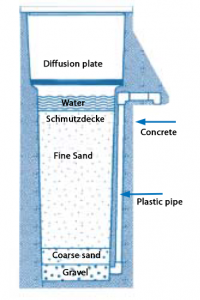While there are a number of water purification technologies in use all over the world, the technology used most often by Pure Water for the World is a biosand filter. It is:

- Low in cost
- Requires no power of any kind
- Reliable. 100%.
- Requires essentially no maintenance
- Simple to use
- Small enough to fit in any home
- Indestructible. Well suited to a school environment.
- Available. Can be built entirely from local materials.
No wonder slow sand filtration has been in widespread use in Europe and America for centuries. On an individual household scale, it’s ideally suited for point of use filtration by rural populations.
The intermittent slow sand filter shown here was developed by Dr. David Manz of the University of Calgary, Alberta. It has been extensively tested in laboratories at the University of Calgary, MIT and Dartmouth College, and has proven economical and effective in thousands of field installations.
The format we use is about the size of an office water cooler, constructed of concrete and plastic pipe (or all plastic), and filled with multiple grades of sand and gravel.
Polluted water is poured into the top of the container through a diffuser plate that controls the rate of flow and prevents disturbing the upper layer of sand.
Removal of most of the contaminants and pathogens in the water takes place near top surface of the sand, up to two inches below the water surface. The organic and inorganic material present in the contaminated water forms at this sand interface, called the Schmutzdecke, or “dirty layer” in German. This biomass is a hostile environment for the organisms that cause human disease, killing most of the pathogens by temperature, competition for food, and predation (on a very small scale!), while mechanically filtering them from the water. Biological destruction and mechanical filtration continue to a lesser extent down through the sand.
Water pressure forces the water through the sand and gravel, up the pipe and out into a clean container. The filtered water is free of contaminants, clear in color, clean in taste and smell, and safe for human consumption.
Many technical reports have been published attesting to the effectiveness of intermittent slow sand filtration. These reports confirm that under optimal operating conditions, the biosand filter is capable of removing 97% of fecal coliform, 100% of giardia cysts, 99.98% cyptosporidium oocysts, 100% of worms, 100% of parasites, and up to 90% of organic and inorganic toxicants from contaminated water.
No moving parts. No external power or sunlight required. Effective in intermittent usage. Centuries of proven results. Low cost. How great is that?
